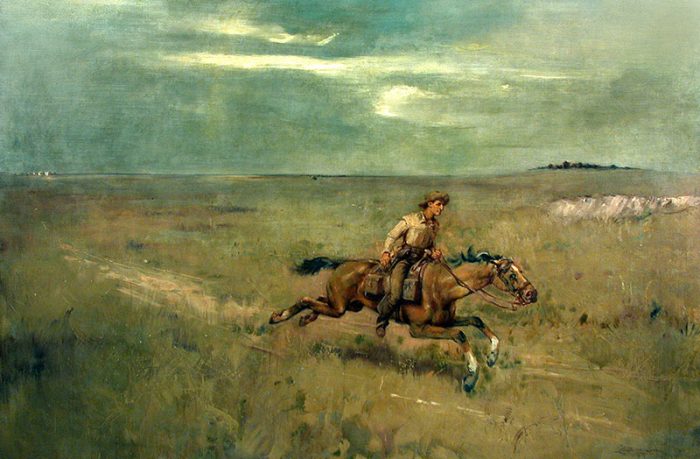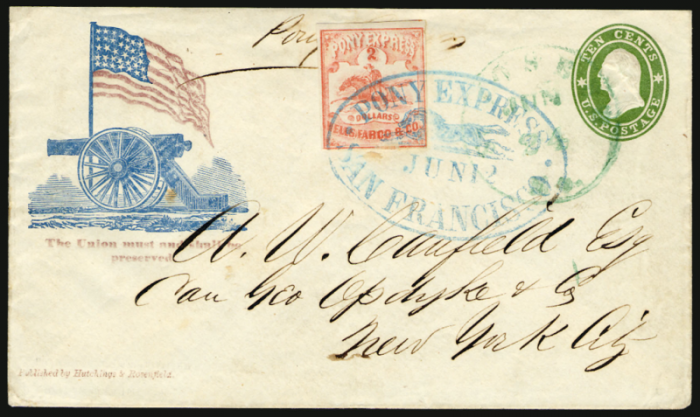Hollywood’s Historical Mishaps: The Pony Express
We’re all familiar with Hollywood’s version of the Pony Express: Brave young men galloping lathered horses across a hostile desert, evading arrows and ambush, as they deliver the mail to the outposts of the West. Would it surprise you to learn that Hollywood’s version may not be completely accurate?
April 3 is the anniversary of the first Pony Express in 1860. In celebration, let’s pop some popcorn and hand the remote to former Postal Museum intern Emily Shapero for a fun, fast and frankly fake film festival.

Pony Express Rider, oil painting possibly by Lloyd Branson (1853-1925) (Courtesy National Postal Museum)
When I was offered the Postal Museum’s Family Programs Internship, I did not expect to add to my resume: “able to quote every line from a variety of old Hollywood westerns and Pony Express TV shows.” After several hours of watching clips of Roy Rogers rescuing damsels in distress and characters from “Bonanza” riding off into the sunset, it was getting difficult to have conversations without a western accent. But it was worth it because these clips are some of the best educational tools around—primarily because they get everything wrong. I knew it would be a challenge to change all of the misconceptions our visitors have about this brief period of American history, so why not tackle them at the source: Hollywood?
I chose six television shows and movies about the Pony Express as evidence of Hollywood’s historical mishaps. Episodes of Bonanza (1966), Young Riders (1989), and The Adventures of Wild Bill Hickok (1951) compose our TV culprits, with Winds of the Wasteland (1936), Young Bill Hickok (1940), and Frontier Pony Express (1939) as our feature-length frauds. I knew it wouldn’t be easy to bust the myths propagated by these slick productions. We had to think of a creative way to (as all experienced museum educators say) interpret them.
Take a look at these video clips and see if you can spot the historical inaccuracies! I’ve listed a few below—and this is just the beginning!
These clips were specially selected for both their high entertainment value and their glaring historical inaccuracies. How many of these errors did you catch?
Mail transfers and the culture of the station house
Riders relied on fresh horses and each other to relay the mail across the west. These clips do a pretty good job of showing that these transfers took place, but most of them leave out one detail: the horn. Some riders carried a horn with them, using it to alert the station masters to be ready with a fresh horse. In a “Young Riders” clip, one of the riders hollers “YAHHHOOOOOO” instead of using a horn, which is what several riders would do instead of carrying a horn. While the show gets that part correct, it also portrays the station house as a very social place. In fact, it was probably quite lonely. As Johnny Dakota tells us, “there never woulda been a whole darned party waitin’ at the station!”
Serious shooting
In many of these clips, the Pony Express riders rely on their guns to get out of tough jams. Whether they faced wild animals or a villain in a black hat, fictional riders were always packing heat. Truthfully though, Pony Express riders rarely carried excessive weaponry. A lighter revolver would have been carried but rifles would have been left behind—they were too heavy. If you want to be fast, you have to be light. Hollywood spices up plot lines with bad guys and wild animals but rarely shows one of the main difficulties on the trail—the weather!
The pony rider as a hero
Although we can call the Pony Express riders of 1860 heroes for their bravery on the trail and their dedication to uniting the nation through mail, they were hardly so in the Hollywood sense. The “Frontier Pony Express” includes a scene in which Roy Rogers chases down a run-away stage coach to rescue a southern belle. Although historical characters like Buffalo Bill probably would have claimed to have done something like this, riders would have been way more focused on getting the mail on its way as quickly as possible.
The pony’s last ride
In one of the last clips, two riders discuss the telegraph and the end of the Pony Express. Luckily for them, Russell, Majors, & Waddell let them take home their ponies at the end of the service. This scene is probably more fact than fiction, especially because the Pony Express was never intended to be a permanent service.
There are two main lessons I’ve learned from busting all of these Pony Express myths. The first: don’t believe everything you see on the silver screen. The second: the true history of something is usually just as, or even more, interesting than the Hollywood version.

“My favorite object at the National Postal Museum relates to the Pony Express because it shows how mail can connect the country in times of crisis. The Pony Express is identified with the run-up and the beginning of the American Civil War. Providing fast information from St. Joseph, Missouri to California during 1860 and 1861, the Pony Express ran while there was no telegraph west of St. Joseph. News of the election of Abraham Lincoln as President reached California by Pony Express. The Museum has a Civil War postal cover, complete with a semi-official Pony Express stamp, the “running pony” cancellation, and the American flag guarded by a cannon on the envelope. This piece of mail shows how letters connected and continues to connect the country in times of crisis.”
— John L., Volunteer and National Postal Museum Society Member
This is an edited version of a post originally published by the National Postal Museum’s blog, “Pushing the Envelope.”
Posted: 3 April 2019
-
Categories:
Education, Access & Outreach , Feature Stories , History and Culture , Postal Museum







